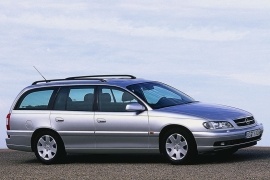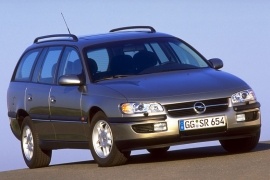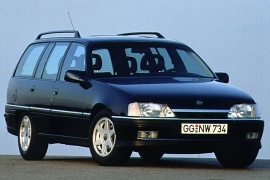OPEL Omega Caravan Models/Series Timeline, Specifications & Photos
First production year: 1986
Engines: Diesel, Gasoline
Body style: Wagon (station wagon, estate, combi, touring)
The 1999 Opel Omega Caravan was the last of its breed. It was the last station-wagon built by Opel with rear-wheel-drive and, by those times standards, it was big.
In the late '90s, the station-wagon era was about to fall and make room for the MPV vehicles. While some car-manufacturers already did the switch, the Opel/Vauxhall still tried to convince people that the station-wagon is a winner, while it was not. But that didn't stop the German car-company, then part of the GM, to build one of the best station-wagon vehicles on the market.
The 1999 version was the last facelift for the aging Opel Omega. While it kept the same wheelbase, it was 7 cm (2.7”) longer than its non-facelifted version. The redesigned front end meant that a new bumper, grille, and headlights were installed. There were also few modifications to the rear bumper. But the overall look of the vehicle remained the same, with the standard roof-rails.
Inside the last of the Omega station-wagon was the addition of a new center console that could include a GPS navigation system with a small display on it. It was not a common feature for a mass-market brand.
Under the hood there were new engines. The newest developed 2.2-liter turbodiesel engine developed in-house and built in a state-of-the-art factory in Kaiserslautern – Germany. It featured a new, direct-injection system with four valves per/cylinder. The diesel versions were also improved by the introduction of the inline-six turbocharged unit from BMW, with a 2.5-liter displacement.
OPEL Omega Caravan 2.2i 16V 4AT RWD (144 HP)
OPEL Omega Caravan 2.2i 16V 5MT RWD (144 HP)
OPEL Omega Caravan 2.5i V6 4AT RWD (170 HP)
OPEL Omega Caravan 2.5i V6 5MT RWD (170 HP)
OPEL Omega Caravan 2.6i V6 4AT RWD (180 HP)
OPEL Omega Caravan 2.6i V6 5MT RWD (180 HP)
OPEL Omega Caravan 3.0i V6 4AT RWD (211 HP)
Opel introduced the Omega's first generation in 1986 to replace the Senator and Rekord, trying to get more market share from BMW 5 Series and Mercedes-Benz E-Class.
Eight years later, the German arm of General Motors introduced a second-generation for its large vehicle, by European standards. It was a significant change that brought new engines, new technologies, and better interiors. GM used the V-platform for it, which used it for the Australian Holden cars and the Cadillac Catera as well.
The station wagon shape featured the same front fascia as its sedan sibling, with sleek headlights and clear turn signals mounted on the corners. Its grille sported a horizontal chromed slat with the Opel badge in the middle. After the B-pillar, the Caravan featured an extended roof that ended in a vertical drop with a liftgate. The carmaker didn't want to cut any corners and used different rear doors for the station wagon than for the sedan.
Inside, the designers had plenty of room to create a spacious cabin fit for five adults. For the front occupants, Opel installed a pair of bucket seats with cloth upholstery for the lower trim level and a leather-clad interior for the top full-spec version. There was a bench for three at the back, although the middle passenger had to ride on top of the tall transmission tunnel. The folding seatback increased the trunk from a decent 541 liters (19.1 cu-ft) to a staggering 1,800 liters (63.6 cu-ft).
Under the hood, GM installed a range of gasoline and diesel engines. A 2.0-liter inline-four powered the base version. It was too weak to lively move the heavy vehicle. The top performer was a fuel-thirsty 3.0-liter V6 that could barely match the 2.8-liter Mercedes-Benz E-Class and higher fuel consumption.
Opel, the former European arm of GM, had to replace both the Rekord and the Senator lineups in the mid-80s, and it did that with the Omega lineup, offered as a sedan or a station wagon, the latter being dubbed as Caravan.
The mid-80s were the best years for introducing a station wagon in the European market. These practical vehicles were used by families and small business owners alike thanks to their massive interior space, at least compared to sedans. So, Opel decided to offer one on the Omega lineup and introduced it in late 1986.
Both Rekord and Senator were already old on the market, and their wedged shapes were no longer appealing to the customers. Opel design center noticed that and offered a vehicle with arched lines. Up to the B-pillar, the long-roof version of the Omega shared the same parts as the sedan. But the rear doors were modified, and behind them, the carmaker added a third row of wide windows. Opel didn't bother too much with raked-forward D-pillars and tried to offer a vast interior.
Inside, the dashboard design followed the same principles as the outside, with curved lines and soft shapes. Moreover, the instrument cluster was integrated into a larger area that also comprised the center stack, where Opel installed the HVAC controls and the stereo. At the back, the folding bench offered plenty of headroom for three passengers. By folding the rear seats, the cargo volume showed an astonishing, for those times, 1,850 liters (65.3 cu-ft). Moreover, with the rear seats folded flat, the loading area reached up to 2 meters (79.4") in length.
Under the hood, Opel installed a wide choice of diesel and gasoline engines paired with either a five-speed manual or a four-speed automatic.


